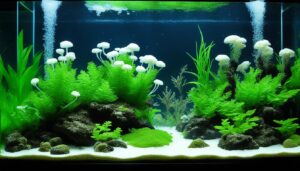Every year, the channel catfish industry loses a whopping $30 million to columnaris saddle back disease. As a writer focused on aquarium diseases and fish health, I aim to shed light on this bacterial threat. This disease, caused by Flavobacterium columnare, affects both commercial fisheries and home aquariums. It highlights the importance of awareness and prevention.
Columnaris is a powerful enemy in the world of fish diseases. It can wipe out freshwater fish populations in just hours. Seeing this rapid decline is tough for any fish keeper. The bacterium can survive in various places, including tank water and river mud, making it a persistent threat.
My own experience with columnaris was a turning point. I saw lesions that looked like saddles, which I thought were harmless at first. But they turned into a serious issue, threatening my fish’s health. So, I set out to learn about the symptoms, treatments, and prevention methods. With the right knowledge and care, we can keep our fish safe and healthy.
Columnaris Saddle Back Disease Explained
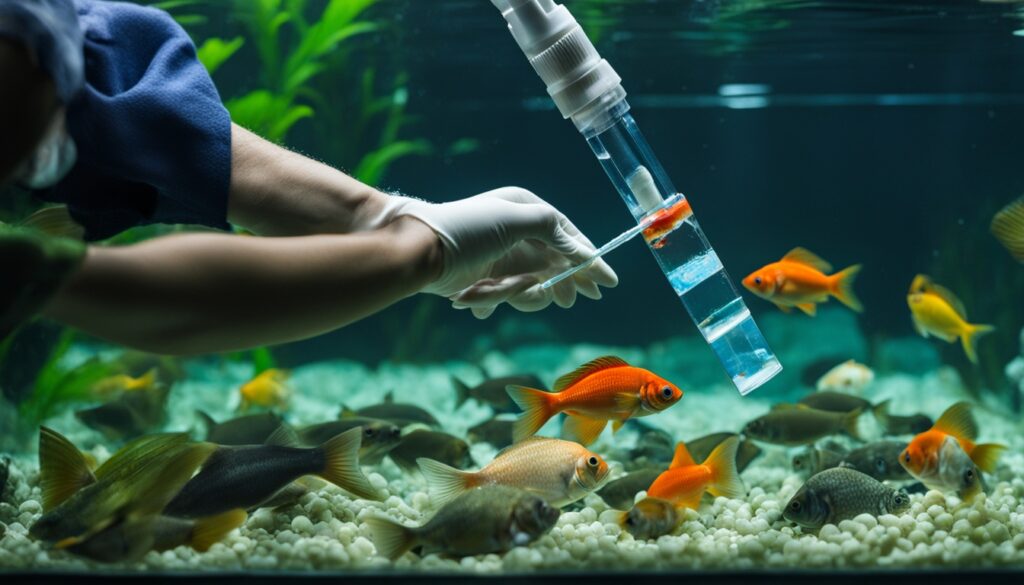
As an enthusiast of the aquatic world, it’s crucial to know how to keep our underwater friends healthy. Columnaris, also known as Cotton Wool Disease or Cotton Mouth Disease, is a big threat to them. Let’s explore what this disease is all about:
What is Columnaris?
Columnaris is caused by the bacterium Flavobacterium columnare. It’s a fast-moving, highly contagious disease in aquarium fish. It thrives in poor water quality or high stress, like in overcrowded tanks or unstable temperatures. Fish with this disease show white or grayish patches that look like cotton on their heads, gills, or fins. They also have ulcers and frayed fins.
Epidemiology and Prevalence in Aquatics
This disease spreads fast and can be deadly if not treated quickly. The bacteria love warm water, especially between 85-90°F. It’s a big problem for popular fish like livebearers, bettas, and catfish. Changes in the tank and injuries make fish more likely to get it. Keeping the tank stable is key to preventing outbreaks.
Comparative Analysis: Columnaris vs. Fungal Infections
Even though it looks like a fungus, Columnaris is a bacterial disease. Getting it wrong can make things worse. It’s faster than fungal infections, often killing fish in 48 to 72 hours. Knowing the difference is key to treating it right.
Understanding Columnaris helps us manage and prevent it in aquarium fish. Keeping the tank clean and watching the fish closely can stop this disease. With this knowledge, we can keep our fish safe and happy.
The Clinical Presentation of Columnaris Saddle Back Disease
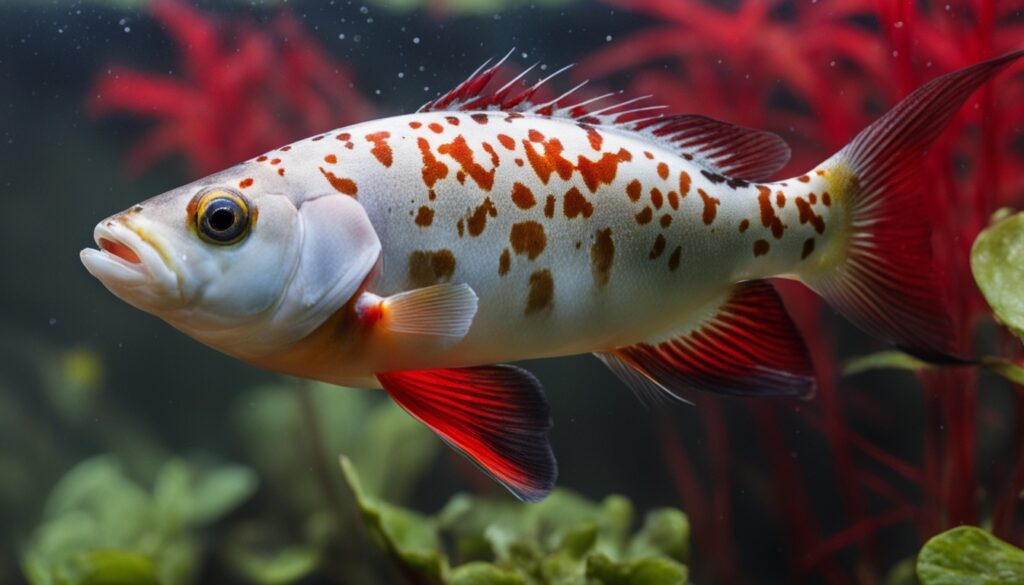
Understanding the signs of columnaris is key to stopping and managing outbreaks in fish farms. This part will explain the different ways the disease shows up, focusing on acute and chronic forms. It will also talk about what makes fish more likely to get the disease.
Symptoms and Identification
Columnaris disease shows many signs that can be confused with other fish illnesses. At first, fish may have discolored skin spots that look like simple cuts. But these spots can turn into worse lesions, like ulcers and fin damage, which are signs of columnaris. In severe cases, a saddleback lesion near the dorsal fin is a clear sign of the disease.
When the fish’s mouth gets affected, it looks bleached and flaky, making eating and breathing hard. Fish care means watching for changes in gill color and texture. Columnaris can make gills look bloody and break down, which is a sign of the disease. This needs quick action to stop things from getting worse.
For more info on the bacteria causing this disease, check out this study. It talks about Flavobacterium columnare, its traits, and how it survives.
Progression of Disease: Acute vs. Chronic Infections
Columnaris can hit fish in two ways: acute and chronic. Acute infections can quickly kill fish, especially in warm weather when the bacteria thrive. Chronic cases move slower and might be less severe, often targeting the skin rather than the gills.
High-Risk Factors and Fish Susceptibility
Many things can make fish more likely to get columnaris. Bad water quality, too many fish in a tank, and poor food can all raise the risk. Even a fish’s genes can affect its chance of getting the disease. By managing these risks, we can lower the chances of columnaris and keep fish healthier in both farms and homes.
### Tips for Aquarium Disease Prevention:
- Keep the water clean by checking it often and making changes as needed.
- Don’t overcrowd the tank to reduce stress on the fish.
- Quarantine new fish to stop infections from spreading.
- Feed the fish a balanced diet that meets their needs.
- Use UV disinfection and control the temperature to fight off bacteria.
By following these steps, aquarists and fish farmers can fight chronic columnaris and other fish diseases. This helps keep fish healthier and longer.
Treatment for Columnaris
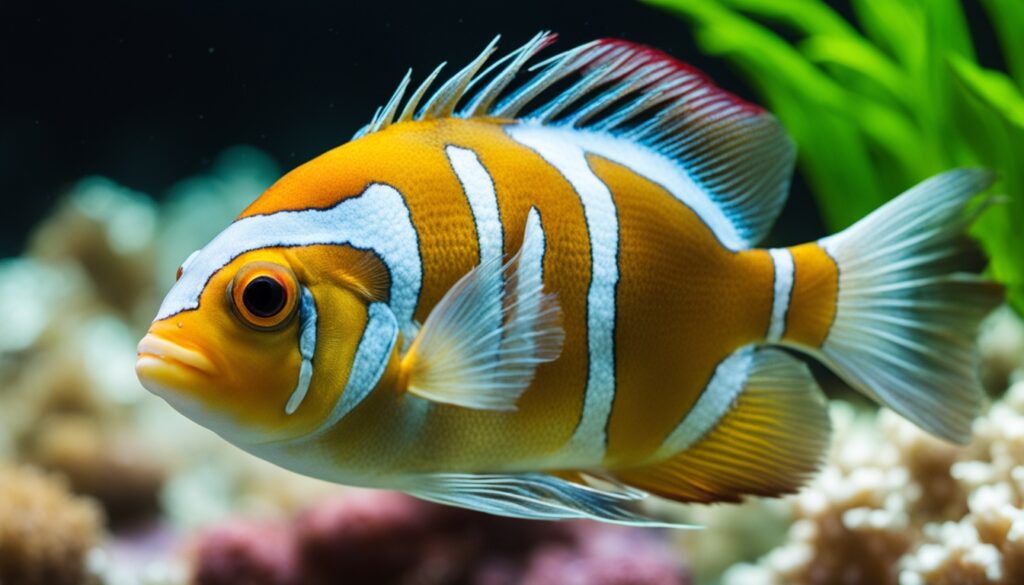
Dealing with columnaris means understanding it’s a bacterial disease. You need to use the right fish bacterial treatments. A mix of direct and supportive treatments works best.
Antibiotic Options and Effectiveness
Antibiotics like Terramycin (oxytetracycline) are key for treating columnaris. You can give it through food or mix it in the tank water. This depends on how bad the outbreak is.
But, use antibiotics carefully to prevent bacteria from becoming resistant.
Using Copper Sulfate and Other Chemical Treatments
Chemicals like copper sulfate are also important. They fight bacteria and parasites. But, be careful because different fish can react differently.
Application of Salt Baths as Supportive Care
Salt baths help fish with columnaris by easing their stress. Use 1-3 teaspoons of salt per gallon to help them recover. But, some fish like catfish can’t handle much salt.
Using these treatments with good tank care helps prevent more problems. Keep the water clean and don’t overcrowd the tank to reduce the risk of columnaris.
Knowing how to use each treatment is key to fighting columnaris. Antibiotics, chemicals, and salt baths work together to make the tank safe for fish. This approach is crucial for treating and managing columnaris over time.
Prevention Tips for Columnaris
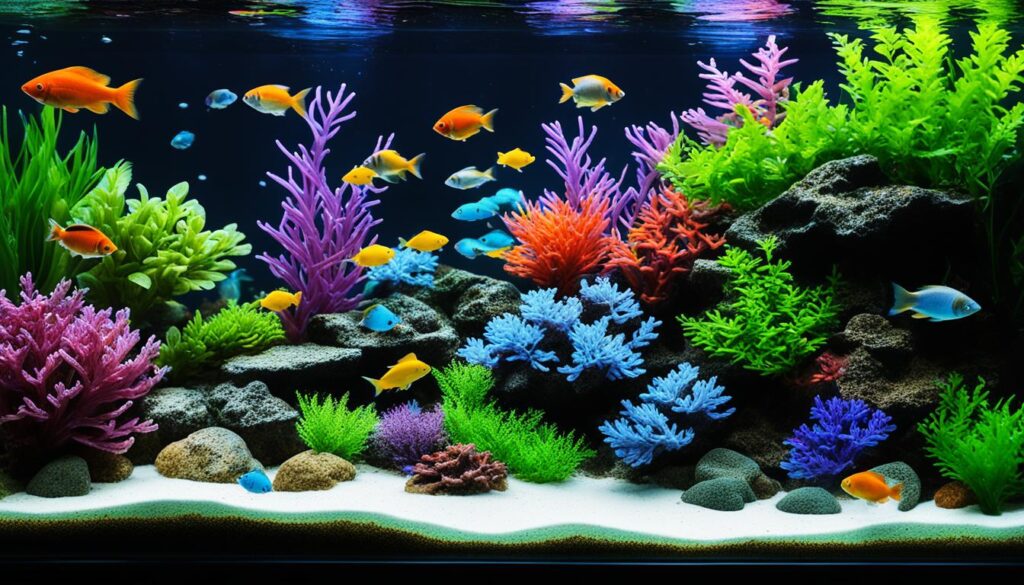
Preventing columnaris, also known as cotton wool disease, starts with good aquarium maintenance. As an aquarium lover, I’ve learned that a healthy environment stops diseases like columnaris. Here are some tips, including regular water changes and quarantine new fish, that keep my aquariums healthy.
- Aquarium Maintenance: Cleaning your tank often is key. Vacuum the gravel to get rid of food waste and debris that can hide harmful bacteria. Also, test the water regularly for ammonia, nitrites, and nitrates to keep it clean and stop bacteria from growing.
- Regular Water Changes: Change 10-20% of your tank’s water every week. This lowers toxins and cuts down on harmful bacteria like Flavobacterium columnare.
- Quarantine New Fish: Keep new fish in a separate tank for two to three weeks before adding them to your main tank. Watch them for illness signs to stop infections like columnaris from spreading.
Following these prevention tips for columnaris can greatly lower the chance of disease in your aquarium. A study showed that proper quarantining and tank care cut down on diseases in both home and commercial aquariums.
Prevention Method |
Benefit |
|---|---|
Regular Maintenance |
Keeps water clean and reduces debris |
Water Changes |
Reduces harmful substances and bacteria |
Quarantine New Fish |
Stops disease from spreading |
Also, keep the water temperature from reaching the ideal range for columnaris bacteria (about 80 degrees Fahrenheit). A temperature of around 75°F can slow down the disease. With these careful routines, we can ensure our fish stay healthy and our tanks stay clean.
Columnaris Fish Treatment
As an aquarium enthusiast, I’ve learned that vigilance is key in fish care and disease prevention. Columnaris, a common bacterial infection, can be a challenge. With proper tank hygiene and quarantine procedures, we can manage and prevent its spread. By using a quarantine tank for sick fish, we can lower the risk of spreading the disease.
My routine to fight columnaris includes creating the best living conditions. I keep the water at 70-72°F and ensure it’s clean. This stops the bacteria from growing. Regular tank cleaning and not overfeeding also help by removing waste and limiting food for the bacteria.
Preventing columnaris is all about balance and consistent care. Avoiding overfeeding helps keep my fish healthy. Treatment usually takes 7-10 days and includes salt, lower temperatures, and medications like Methylene Blue. If antibiotics are needed, we use them carefully to protect the environment and help the fish in the long run. With these steps, my aquarium stays healthy and safe from columnaris.

